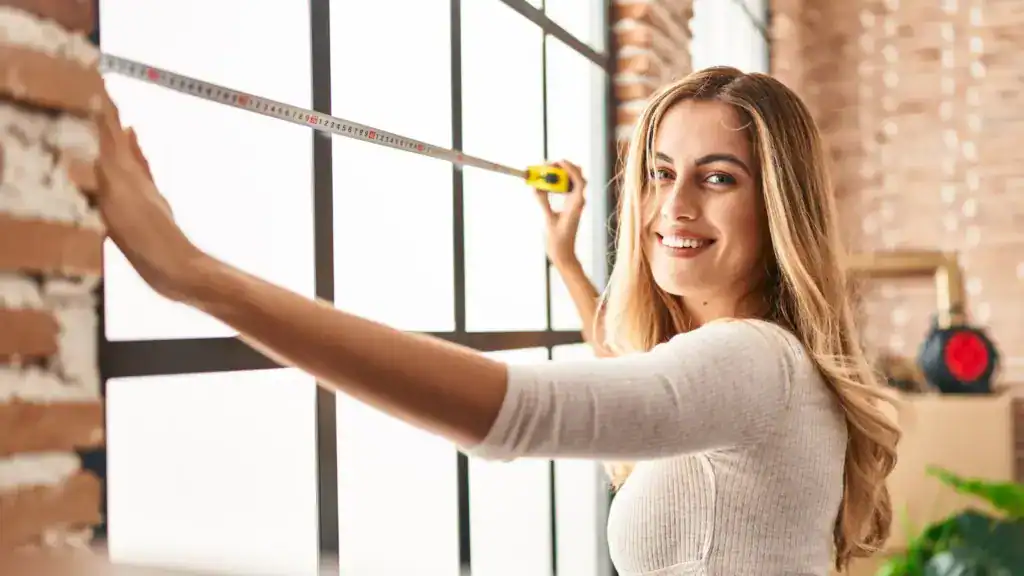How to Hang Bay Window Curtains: Mastering the Art

Bay windows are beautiful but tricky. They add character and light to a room but can expose you.
The windows bow outward, maximizing natural light and presenting a panoramic view of the outdoors.
However, the very features that make bay windows so appealing can make it hard to cover them. The angles and varying widths require thoughtful planning to ensure the window treatments fit.
You can opt for shades or mini blinds, giving each window panel its own shade or set of blinds. But what if your heart’s set on curtains?
The good news is that with the right approach, you can conquer the unique geometry of a bay window to hang the curtains of your dreams.
Choosing the Right Curtain Style
The style you choose will affect light control, insulation, and privacy.
Full-Length Drapes
Full-length drapes have a classic and elegant look.
Pros
- Provide maximum coverage
- Offer privacy and insulation
- Add height to the room
Cons
- Expensive
- Require more fabric than other styles
Sheer Curtains
Sheer curtains cast a romantic glow in the room.
Pros
- Allow natural light to filter through while still offering some privacy
- Inexpensive
Cons
- Provide minimal insulation and light control
- Can be too sheer for complete privacy
Café Curtains
Café curtains cover only the bottom half or two-thirds of a window. They’re typically paired with a valance at the top.
Pros
- Budget-friendly option
- Allow a view outside while providing partial privacy
Cons
- Not suitable for every room
- Can make a space look smaller
Layered Curtains
Layered curtains combine multiple curtain types to achieve maximum functionality and style.
Pros
- Versatile; you can mix sheer and heavier drapes for balanced light and privacy control
- Enhance a room’s aesthetic with depth and texture
- Offer excellent insulation and soundproofing
Cons
- Can be more expensive due to the need for multiple fabric types
- Require additional hardware and installation effort
Selecting the Right Fabric
The fabric you choose will impact the appearance and functionality of your curtains.
- Light Control: Opt for heavier fabrics like velvet or lined polyester for better light control and sound dampening.
- Privacy: Thicker fabrics prevent outsiders from peering in while insulating the room.
- Aesthetic Appeal: Consider sheer fabrics for a softer look. Assess the room’s color scheme and decor. Neutral tones blend seamlessly, while bold colors make a statement.
Measuring Your Bay Window
- Measure the width of each window panel separately. This ensures your curtains will fit each section precisely. Add a few inches to each measurement to account for overlap and fullness.
- Decide where you want your curtains to start and stop. Measure from this point to the desired length, whether just below the window sill or to the floor.
- Note any angles or curves in your bay window. This information is crucial when selecting rods or tracks to fit the window’s shape.
Selecting Curtain Rods & Tracks
Here, you have several options:
- Bay window curtain rods are adjustable and can bend to fit the contours of your window. They’re ideal for full-length drapes.
- Flexible tracks can be cut to size and easily follow the window’s shape, making them perfect for lightweight curtains.
- Corner connectors let you join standard rods at the angles of your bay window, providing a custom look without a custom price.
Other Hardware Options
- Tension rods are excellent for lightweight curtains and don’t require drilling. They expand to fit snugly within each window panel.
- Ceiling-mounted tracks allow the curtains to hang from above. This highlights the window’s shape and creates a dramatic floor-to-ceiling effect. This setup achieves a clean line and can work with various curtain styles.
- Swivel brackets, used with standard rods, allow you to change the angle of your curtain rods to accommodate the curves of a bay window.
Installing Your Curtains
- Mark the spots where you’ll install the brackets or track supports. Make sure they’re evenly spaced and level.
- Drill holes at the marked spots. Use the appropriate drill bit for your wall type, whether drywall, plaster, or wood.
- Attach the brackets or tracks. They should be level and strong enough to support the weight of your curtains.
- Hang your curtains on the rods or tracks. Adjust them as needed so that they hang evenly and operate smoothly.
Finishing Touches
- Tiebacks or holdbacks can keep your curtains open and add a decorative flair.
- Valances or cornices provide a finished look and hide the hardware.
- Curtain rings with clips are perfect for lightweight curtains without rod pockets. They also allow you to easily change curtains whenever you want.
Maintaining Your Curtains
- Use a vacuum with an upholstery attachment to remove dust and dirt. This prevents buildup and keeps the fabric looking fresh.
- Always follow the manufacturer’s care instructions. Some fabrics may be machine washable, while others require dry cleaning.
- Rotate your curtains periodically to ensure even wear. This is especially important if one side is exposed to more sunlight.
Budget-Friendly Tips
- Consider making your own curtain rods using PVC pipes or wooden dowels. You can paint them to match your decor and fit them with affordable fixtures.
- Search thrift stores for gently used curtains or fabric that can be repurposed. You’d be surprised at the treasures you might find.
- Choose simple, solid fabrics. These are often less expensive than patterned ones but can still make a statement when styled creatively.
Common Mistakes to Avoid
- Never skip measuring your windows. Inaccurate measurements lead to ill-fitting curtains and wasted time.
- Verify that the hardware you choose can support the weight of your curtains. Heavy fabrics need sturdy rods or tracks.
- Consider the direction your windows face and select fabric accordingly. You may need light-filtering or blackout curtains.
FAQs: Hanging Curtains in a Bay Window
Q: What’s the best type of curtain for bay windows?
That depends on your style and needs. Layered curtains provide optimal light control. Sheer fabrics create a romantic look. Thicker fabrics provide maximum insulation and privacy.
Q: How do I measure my bay window for curtains?
Measure the width of each panel separately and add a few inches to allow for overlap and fullness. Decide on your desired length and note any angles or curves in the window.
Q: Can I use regular curtain rods on my bay window?
Yes, as long as they can be adjusted or joined together with corner connectors to fit the angles of your bay window.
Q: What if my windows are different sizes?
You may need rods or tracks of different sizes for each panel. Alternatively, you can hang individual curtains for each section.
Q: Can I hang my curtains from the ceiling instead of the wall?
Yes, ceiling-mounted tracks offer a clean and dramatic look. Just make sure they’re strong enough to support the weight of your curtains.
Q: How can I make my bay window look bigger?
Curtains extending beyond your bay window’s width can create the illusion of a larger window. Hanging them higher above the top of the window also draws attention upward, making the space appear taller.
Q: Are valances necessary for bay window treatments?
No, but they can enhance the aesthetic appeal by concealing hardware and adding a layer of sophistication. They’re especially effective if you want a more formal look.
Q: What are some creative ways to enhance bay window treatments?
Incorporate decorative curtain tiebacks or holdbacks for an elegant look, or add a decorative rod for visual interest. To coordinate the decor in your bay window seating area, complement your curtains with matching cushions or throws.


